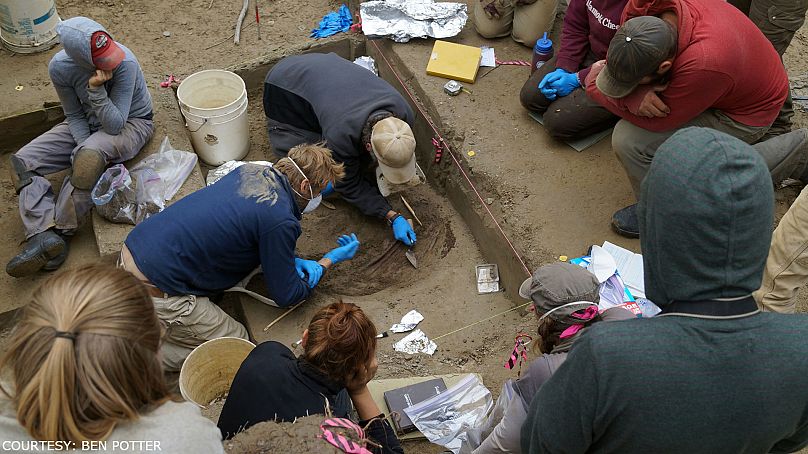Genetic analysis of a baby girl who died at the end of the last ice age has uncovered a new group of Native Americans: the ancient Beringians.
Genetic analysis of a baby girl who died at the end of the last ice age has uncovered a new group of Native Americans: the ancient Beringians.
The infant, who was six weeks old when she died, was exhumed by a team of field archaeologists in what is now Alaska.
Dr J. Víctor Moreno-Mayar from the Centre for GeoGenetics, University of Copenhagen, told Euronews how archaeologists from the University of Alaska Fairbanks have been digging at a site called the Upward Sun River for several years looking for clues about the native people of the Americas.
He said the team found a cremated body in the same location, and that "it was this discovery that made them decide to keep digging and uncovered two non-cremated bodies in 2013".
While one of the 11,500-year-old remains returned unsatisfactory results, those of the baby girl allowed researchers to analyse the oldest full genome to be sequenced from the Americas.
The girl, named Xach’itee’aanenh t’eede gaay or "sunrise girl-child" by the local indigenous community, are the earliest known in the far north of North America.
Why is the discovery so significant?
The findings help disambiguate the picture of one of humanity's greatest migrations, supporting the idea that a single wave of migrants reached the New World by way of a now-submerged land bridge that used to connect Asia to Alaska just over 20,000 years ago.
Lower sea-levels back then would have created dry land in the Bering Strait connecting Siberia and Alaska.
It would have submerged again only as northern ice sheets melted and retreated.
The pioneering settlers became the ancestors of all today's Native Americans.
The new paper supports a theory that the migrants from Asia spent thousands of years in isolation, either in Beringea or Asia, before entering the Americas.
This is an achievement that lets researchers estimate the timing of key events in the ancestral history of today's Native Americans and indigenous peoples of Canada and Central and South America.
While the new paper doesn't radically change the outlines of what scientists have thought, it does provide more detail and better evidence than what was available before.
How was the girl's DNA examined?
By comparing the genetic details of the Alaskan infant to those of genomes from other populations, the researchers were able to estimate the times of key events in the overall process outlined above.
Moreno-Mayar describes the genome of a person "like the layers of a book".
A copy of the book is passed on from parents to children but each time a copy (genome) is made, errors or mutations, are passed on at a constant rate.
It is the differences in these copies that are compared when discerning if two beings are closely related—recent ancestors' books, or genomes, would be more similar.
Who were the tribe?
Moreno-Mayar said the girl's people "were very well adapted to the difficult living conditions".
Organising themselves into small groups that were very mobile allowed them to exploit the land as hunter-gatherers.














